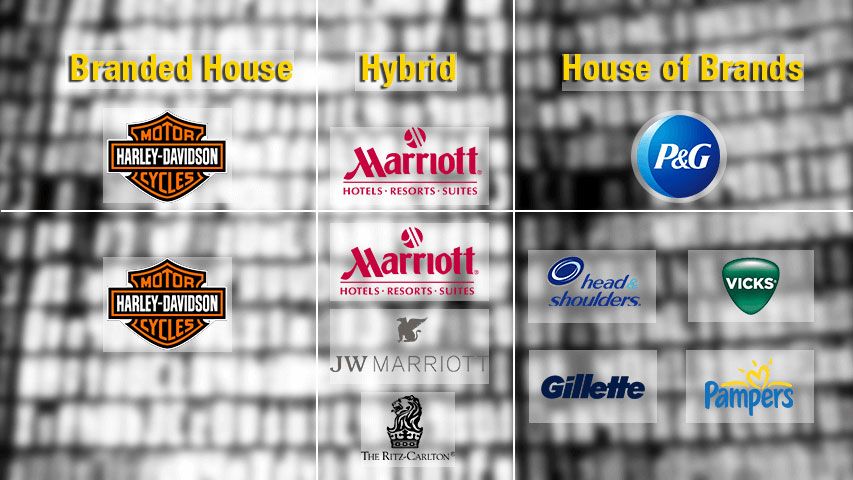
Let’s face it, we have seen good products fail to take off in the market.
Even products from popular companies: they carry a powerful brand, they’re impressive—but for some reason they fall flat in the market.
We learn that sometimes big brands fail due to their branding getting in the way. That’s because the problem can sometimes come from their brand architecture.
Once you know how brand architecture can make or break your branding, you can nip problems in the bud and start building your business on the right foot.

Brands that don’t ride together, die together
Brands that don’t ride together, die together
Let’s first take a look at what brand architecture is. When a company owns a portfolio of sub-brands, it needs to organize them into a structure that makes sense to marketers and consumers.
Within this totality of offerings, how the sub-brands differ from each other within the same company matters to whether they thrive or fail.
Ultimately, it’s the company’s job to ensure that this architecture of its portfolio makes sense.
But this is not the same as organizational structure, because it’s not merely an internal structure. It defines how the customer thinks about your business as a whole.
When done right, brand architecture helps a company’s marketers meet the needs of its customers effectively and fully realize the value of its offerings, including the synergistic potential of equity transfer between brands. The strength of one brand can boost the appeal of its sub-brand by association, while the complementary value between sub-brands provides opportunities for cross-selling. As for consumers, good brand architecture gives them clarity on how their specific needs can be met depending on the brand they engage with, as the value of each brand is differentiated with clarity and persuasively communicated. When they know what a company is truly about, its marketing efforts won’t get lost in translation.
Brand architecture that‘s done poorly on the other hand confuses customers, spoils the marketing of otherwise good brands, and doesn’t allow a company to effectively plan its business for the future.
Rather than leveraging the equity of associated brands to heighten their appeal in the market, they have brands cannibalizing each other. There are brands in a company’s mix that receive little to no support. A long-standing brand gets diluted as it starts entering categories beyond its core expertise. Ultimately customers won‘t be able to properly understand the value offered by any brand that’s managed within a haphazard portfolio.

(From Right) Branded House, Hybrid, House of Brands
Choosing the right fit for your business
There are 3 basic configurations for brand architecture.
- Branded House
- House of Brands
- Hybrid / Endorsed Brands
Branded House:
The house is the brand. Where a well-established master brand has its name on all sub-brands, products, or services.
Strength(s): Develops strong master brand, optimal for cost efficiency
Weakness(es): Difficult to expand beyond several categories without brand dilution
Example: Apple – iPhone, iPad, Apple TV, Apple Music etc.
House of Brands:
The house includes many brands. Where the name of the master brand is either less pronounced or not present in the sub-brands; each sub-brand has its own distinct brand identity.
Strength(s): Develops strong standalone brands in different categories, promotes flexibility
Weakness(es): High investment costs, individual marketing of brands increases complexity
Example: Nestle – Milo, Maggi, Nescafe, KitKat etc.
Hybrid/Endorsed Brand:
Where there is the best of both branded house and house of brands. Companies that comprise a mixture of sub-brands, those that are extensions of the master brand (akin to branded house types) and those that have standalone identities.
Strength(s): Optimal for flexibility where strong master brand could be leveraged or not
Weakness(es): Demands intricate planning, messy when resulted from poor planning
Example: Sony – PlayStation, Bravia, Sony Pictures, Xperia, Walkman etc.
So which configuration is most suited for your business?
It depends on several considerations:
What your existing brand architecture looks like for your overall strategy: Working from where you’ve grown to organically is less daunting (and costly) than starting from scratch. By auditing your current structure, you can find out where your company’s priorities have been, and where you intend to move from there. Can the current architecture align with your company’s long-term marketing strategy with some tweaks, or do you need to start performing a major overhaul?
How clear the connections are within the architecture:
The simple rule of leveraging the relationships within brand architecture is the clarity of connections between brands for consumers. If they can’t see how your sub-brands connect, you won’t be able to help your sub-brands cross-promote effectively. More importantly, you need to be clear on how your brands connect. The configuration that serves your overall marketing strategy depends on how much you want your sub-brands to be loosely or closely linked to your master brand.
How you respond to the market now and in the future:
Disruption is around the corner. Your company is on the move. You’re meeting the market as it shifts. In doing so, are you planning a merger or acquisition? What industry segments are you aiming to penetrate? Within these plans you’ll also need to determine the strategic priority of your brands. Which of your brands is key to your company’s future? Which one is the cash cow? Which one needs to be culled? Your company is responding to competitors and the changing tides of the market, so your brand architecture has to take these factors into account. It needs to not only support your current mobility but also not get in the way.

A comparison of Apple’s and Sony’s Brand Architecture
Brand architecture applied – Sony vs Apple
Apple is a good example of branding done right, and it shows in their brand architecture. Even with a standardized brand vocabulary (minimalist, white, clean) and a uniform naming structure (iPhone, iPad, iMac) across the company’s portfolio, it is easy to distinguish between their product lineups. When we examine their offerings we know how each different product would meet our different needs. At the same time, there’s no product that is out of place. When they launch a new product, we have a good sense of where it fits into the Apple ecosystem.
In the meantime, companies like Sony, who despite having some pioneering and industry-leading products like the PlayStation gaming console series, walks a tightrope due to inherent drawbacks in their brand architecture as it relates to their overall strategy. Because the Sony brand is synonymous with premium products, the company has to attach premium prices to any product that bore the Sony name, even if it is a losing strategy in the product’s given industry segment.
As a result, otherwise good offerings such as the Xperia smartphone series and VAIO laptops suffered heavily in their respective industry segments. As long as they came from Sony, they had to be priced higher than products that performed similarly even when it leads to significant sales losses year after year. Coupled by the fact that the brand spreads out across a broad variety of electronics industries and industry segments, this one-size-fits-all approach spells certain loss for some of the brand’s product lineups.
What’s interesting is that both Apple and Sony pursued the same strategy for their smartphones and laptops. They both sell high quality consumer electronic products at premium prices. The difference is Apple’s brand architecture is laser focused as a personal computer lifestyle brand within a few key segments whereas the Sony brand is spread thin across many industries. When choosing a premium smartphone, the focused brand here is the clear choice.
This is not to say that Sony’s brand architecture (hybrid/endorsed brand) isn’t working. However, in this instance perhaps the master brand is too closely linked with the Xperia and VAIO sub-brands that it offered no flexibility for them to properly adapt to their industry segments. As a long-standing electronics giant, Sony has a lot to negotiate within its brand architecture, and culling sub-brands that underperform isn’t always the answer.
Bottom line – healthy branding is systemic branding
When a company has a problem with products that underperform in the market, examining its place within brand architecture may help to identify and/or solve its problem. The need for good organization in this regard is inevitable as companies grow. What starts out as a core brand eventually develops or branches off into new sub-brands to capture market opportunities or meet emerging needs. In any case, the result is a bigger portfolio. How this growth is managed is crucial to a company’s health in the long run.




